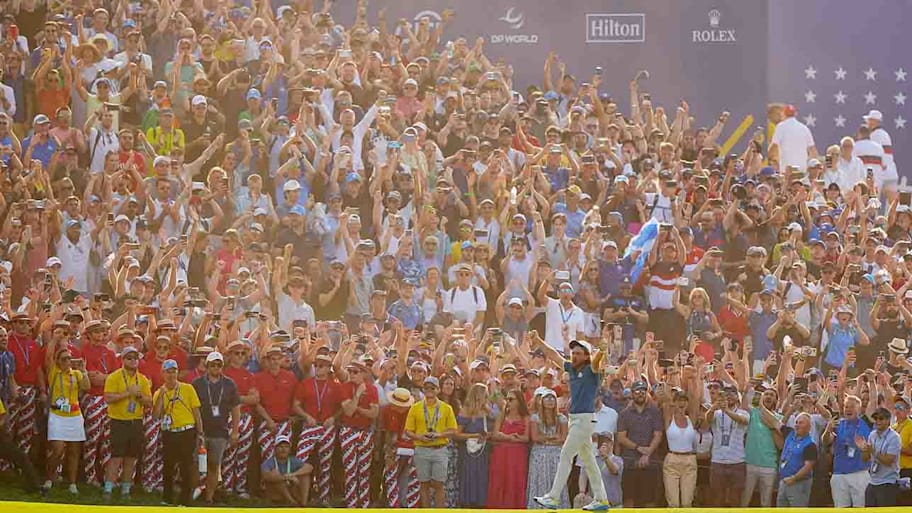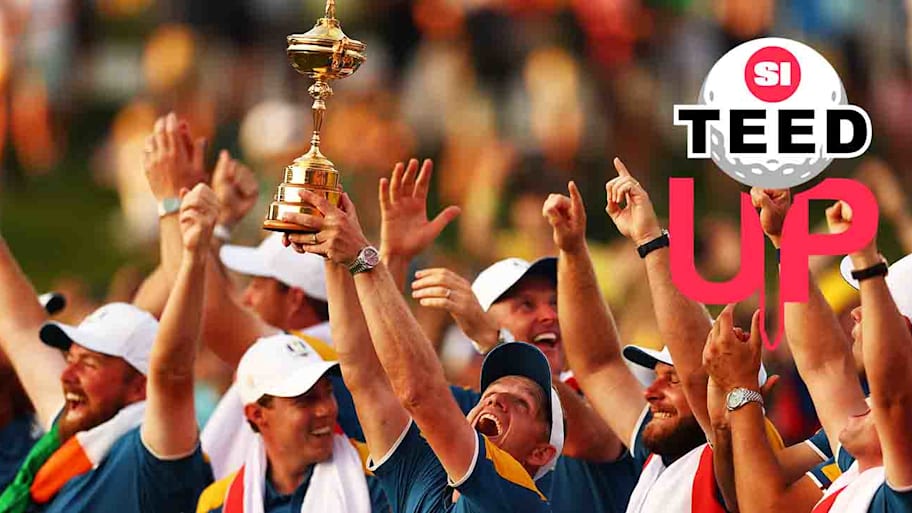It’s Ryder Cup all the time, like it or not. With virtually no other high-level golf taking place over the past several days (apologies to the French Open and the U.S. Mid-Amateur), the focus is on the biennial competition that’s already been discussed for weeks and will continue to be until the first golf balls is in the air at Bethpage Black on Friday morning—and beyond.
The event is undoubtedly one of the biggest on the golf calendar, rivaling the Masters in popularity and the source of considerable conjecture for weeks on end. It all but bankrolls the DP World Tour and fills the coffers of the PGA of America, too.
And to think, it wasn’t terribly long ago that the event was not televised live in the United States.
That’s no longer an issue, as there will be wall-to-wall coverage of the Ryder Cup, with plenty of preliminary chatter to keep you going until the marathon foursomes and fourball sessions take place on the Black Course on Friday.
Here is some of the important—and perhaps not so important—info to digest at the Ryder Cup draws near.
45th Ryder Cup: The basics
Record: the U.S. leads 27–15–2.
Format: Foursomes (alternate shot) and Fourball (better ball) on Friday and Saturday (16 total matches, 4 in each session). Singles (12 matches).
Winner: The first to 14½ points. Europe retains the Cup if there is a tie.
TV: Friday, 7 a.m.–6 p.m. (USA Network, Sky Sports); Saturday, 7 a.m.–6 p.m. (NBC/Peacock, Sky Sports); Sunday, Noon–6 p.m. (NBC/Peacock, Sky Sports). Peacock and RyderCup.com will have featured groups.
The venue
Bethpage State Park in Farmingdale, N.Y., is the site of the Ryder Cup, a well-known property that is home to the Black course, a stout 7,468-yard par-71 that has hosted the 2002 U.S. Open (won by Tiger Woods), 2009 U.S. Open (Lucas Glover) and 2019 PGA Championship (Brooks Koepka). It was also home to the Barclays, a FedEx Cup playoff event, in 2012 (Nick Watney) and 2016 (Patrick Reed). The Black course is not only known for its difficulty, but also for its accessibility to the public. Walk-up spots are often secured by players sleeping overnight in the parking lot.
The beginning
The Ryder Cup had a rather humble start. A British seed merchant named Samuel Ryder had this noble idea for a team competition among “American and British” professionals. It started in 1927, included players from Ireland, and Ryder even commissioned a trophy with a small figure on top. Who is it? Abe Mitchell. Oh? Yeah, Ryder’s golf coach. Give the powers that be some credit for not selling out the naming rights or the trophy.
The Sleepy Era
A good bit of attention was focused this year on whether or not Keegan Bradley would be a playing captain for the Americans. In the early days, the captain almost always played. Walter Hagen led the first six U.S. teams which won four of them. Hagen played on the first five teams. The Great Britain & Ireland team had 10 playing captains through 1961. After the initial six contests, World War II put the Ryder Cup on hold. (The 1939 matches were scheduled to be held at the Ponte Vedra Inn & Club in Florida, which is down the road from current PGA Tour headquarters.) When the competition resumed in 1947, the U.S. went on a run of domination that saw it win 10 of 11 times.
The concession
Long observed as one of golf’s great acts of sponsorship, the 1969 Ryder Cup ended in a 16-16 tie when—playing in the last singles match on the last day—Jack Nicklaus conceded a short par putt to England’s Tony Jacklin. Had Jacklin missed, the U.S. could have won the Cup outright. “God only knows what he must have been thinking,'' Jacklin said. "All of a sudden, he's got a 4½-footer to make (after running a birdie putt past the hole), and if he misses, his team loses the match. And then, in a split second he holes the putt and he's picking his ball out of the hole, and he picks my marker up at the same time. So he's run it all through his mind. He must have.” It was the first tie in Ryder Cup history and only the second time Great Britain & Ireland didn’t lose 1933, the only victory coming in 1937. Of historical significance: due to PGA of America membership rules at the time, Nicklaus was playing in his first Ryder Cup, having already won seven major titles.
The big change
At Jack Nicklaus’s urging, the Ryder Cup expanded the playing participants. Instead of just players from Great Britain & Ireland, the squad was to include all of Europe. This opened the doors to some of the greatest talents such as Seve Ballesteros and Bernhard Langer and later Sergio Garcia, the event’s all-time points leader. Still, in 1979, with an expanded roster, the European side was trounced 17–11 when the format was changed to the current 28 points. In 1981, the U.S. fielded a powerhouse team that had 11 players who had or would win major championships. An 18½ to 9½ victory ensued over a European team that had Nick Faldo, Bernhard Langer and Sandy Lyle. At this point, the side from across the Atlantic had still won just three times.
The real change
It was going to take more than adding the entire continent of Europe. It took a transformational figure in Tony Jacklin who became captain just a few months before the 1983 matches at PGA National against Jack Nicklaus. Jacklin, an Englishman who won the 1969 British Open and the 1970 U.S. Open, took the job after unceremoniously be left off the 1981 team and feeling slighted. Seve Ballesteros, due to a dispute over appearance fees, also did not play in 1981. Among Jacklin’s demands: better uniforms and shoes, a team room, first-class accommodations ... and transportation to the U.S. via the Concorde. “I said I want carte blanche to address these things,” Jacklin said. “They kept saying O.K. Went through the list. ‘Whatever you want.’ And I said on that basis, I'll do it.”
The Jacklin Era
Tony Jacklin convinced Seve Ballesteros to return to the Ryder Cup. He instilled a sense of passion and pride. He gave the European team belief. He fought for captain’s picks. He altered the lineup to better put strength where he felt it was best suited. The Europeans lost to the Americans 14½ to 13½ in Jack Nicklaus’s backyard in Florida but it was a tense, close match. For the first time, the Ryder Cup was televised in the United States—on tape delay on ABC. Two years later at The Belfry, Jacklin captained the Europeans to their first victory in the Ryder Cup since 1957. “And there was a sense of expectation in front of a home crowd because of what we'd achieved in ’83 despite being beat in the end,” he said. “That confidence as opposed to bravado was there. That was the thing that would change the outcome.” Two years later, Jacklin dealt Nicklaus a defeat on his home course at Murfield Village, the first time the Europeans won in America. And in 1989, the Europeans forged the second tie in Ryder Cup history, retaining the Cup for a third time. Jacklin went 2–1–1 as captain.
The European wave
Starting with Tony Jacklin’s captaincy in 1983, there have been 20 Ryder Cups through 2023. Europe is 12–7–1 during that time. It has not lost at home since 1993 and won in America in 1987, 1995, 2004 and 2012.
The numbers
From 1995 to 2014, Europe won eight out of 10 Ryder Cups, twice capturing three in a row. A good bit of that time saw the Americans have superstars Tiger Woods and Phil Mickelson on the same team. For whatever reason, Woods and Mickelson could never parlay their individual success into Ryder Cup glory. Woods went 13–21–3 in eight appearances, 4–2–2 in singles. His singles defeats came in 1997 (when a loss to Costantino Rocca was but one factor in an overall 14½ to 13½ defeat) and in 2012—when he led Francesco Molinari heading to the 18th but lost the hole in uninspired fashion when a tied hole would have at least given the Americans a 14–14 tie. Mickelson admirably was on 12 teams starting in 1995 through 2018 and was 18–22–7. He leads the Ryder Cup in losses and matches played with 47. Mickelson controversially played a role in shaking up the U.S. Ryder Cup dynamic following the 2014 defeat at Gleneagles that led to a task force and an overhaul in the system. The result has been mixed, with better cooperation with the Presidents Cup and a couple of home blowout wins and a captain succession plan—with was deviated from this time with the appointment of Keegan Bradley.

The stars from Spain
Seve Ballesteros went 20–12–5 in eight Ryder Cup appearances. He formed the best partnership ever with Jose Maria Olazabal, going 11–2–2. Both players captained European victories. Sergio Garcia is the all-time Ryder Cup points leader (25–13–7) with 28½ points. Jon Rahm is 6–3–3 (he beat Tiger Woods in his first singles appearance in 2018) and will be making his fourth Ryder Cup star this week.
The forgotten star, remembered
Larry Nelson went 9–3–1 across three Ryder Cups for the U.S. and won three major championships. All after serving in Vietnam and taking up golf at age 21. He was passed over for a U.S. Ryder Cup captaincy but U.S. captain Keegan Bradley is attempting to make amends this year by naming Nelson a Ryder Cup ambassador. Nelson will be on the scene in the team room and at various functions for the U.S. side. It is a nice gesture for Nelson, 77, who went 5–0 in his first Ryder Cup in 1979.
Pride over prize money*
One of the beauties of the Ryder Cup is there is no prize money. It’s all about pride, and it is immense. Playing for your country or continent. Your teammates. Your tour. Of course, there is a twist on this starting in 2025. Although the Americans for more than 25 years have been receiving funds to donate to a charity of their choice, they will now also get to pocket some, too. It is highly controversial. But $500,000 will be earmarked for each player and the captains, with $300,000 going to charity and the players having the option to keep $200,000. The PGA of America can certainly afford it. The event generates millions on the back of the players. But it nonetheless came with plenty of angst. The European players will each receive $0.
The tally
Since 1979, the European resurgence has made the Ryder Cup what it is today. Instead of a sleepy event, it is one of the best in golf, filled with passion and emotion. The U.S. has suffered some humbling defeats during that time, but the overall scorecard reads Europe 12, USA 9 and one tie. And the points across all of those matches have been relatively close. That hasn’t been the case over the past five Ryder Cups. No reason why it won’t be this week. And that’s why we watch.
This article was originally published on www.si.com as A Ryder Cup Primer for the Massive Week at Bethpage Black.
